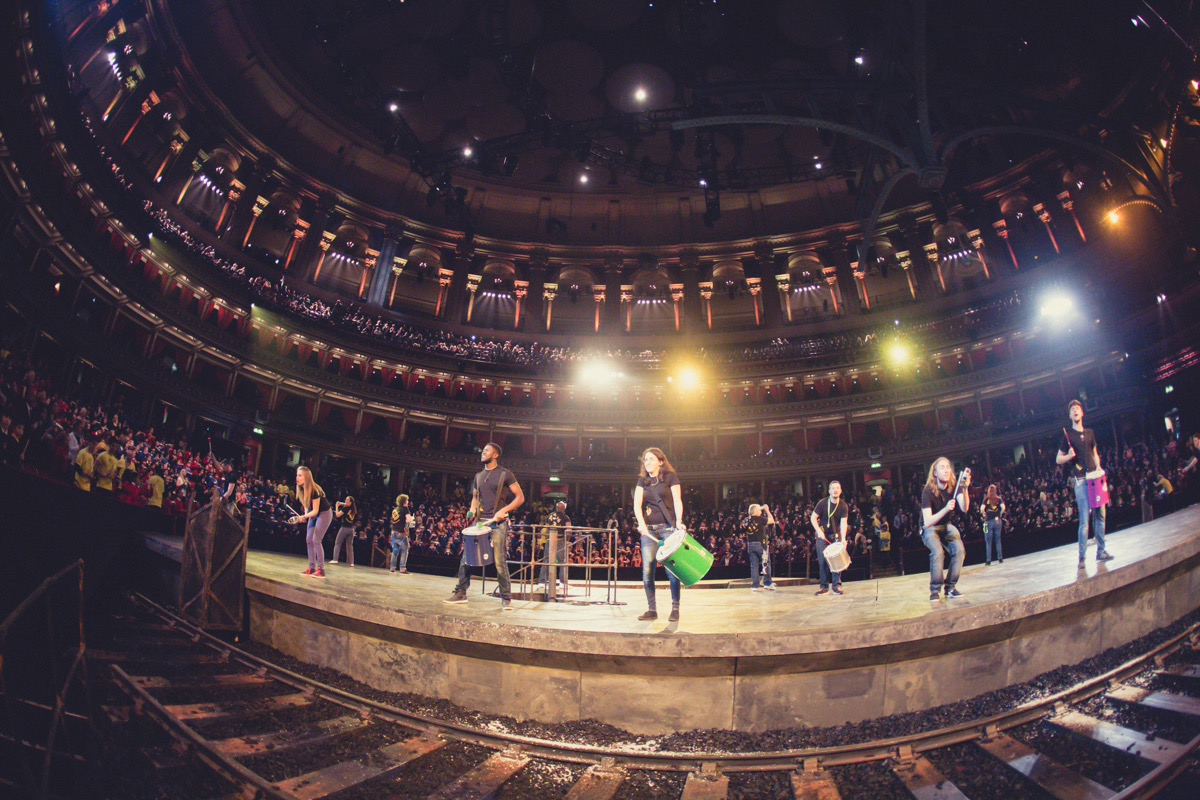In this 2nd blog of the series, our weekly blogs will focus on giving tips for teaching different genres of world-music in the classroom. Regardless of the genre, our tips will always come under the following headings which we believe are the most important areas to think about when teaching a world-music lesson or scheme of work:
Instrumentation
Technique
Cultural Significance & Classic Motifs
Leadership & Classroom Management
This week we’re focusing on teaching Brazilian samba drumming. The previous blog focused on West African drumming.
There is a difference in instrumentation and musical style between Rio-style samba and Salvador-style samba reggae. Your available resources may determine the style of samba you create in the classroom. A Rio samba bateria would consist of surdos (bass drums), repeniques (tightly tuned tenor drums), caixas (snare drums), agogo bells, ganzas (shakers) and tamborims (jingle-less 6” tambourines tightly tuned and played with a thin plastic stick). A samba reggae bateria would not include tamborims, agogos or ganzas, and would have a higher proportion of surdos who play impressive semiquaver features – often swinging the drums above their heads! If you have a drum kit available, it could easily create either a Rio samba or samba reggae by using the toms as replacement surdos and the snare as a caixa. Any shaker will be suitable replacement for a ganza, cowbells for agogos, and tightly tuned small tambours (or even hand claps) for tamborims.
The Key Stage 2 Inspire-works 15-player samba pack consists of three groups of instruments that create a very balanced ensemble for a Rio-style samba and also work really well for swapping instruments – by simply swapping instruments twice per lesson, everyone will have played an instrument in all three groups:
Group 1:
1 x 16” Nesting Surdo
1 x 14” Nesting Surdo
1 x 12” Nesting Surdo
1 x 10” Nesting repenique
1 x 8” Caixa
Group 2:
3 x ganza
2 x agogo
Group 3:
5 x tamborims
An Inspire-works Brazilian samba drumming CPD session!
Bigger is not better for samba! There are surdos on the market that are up to 22” diameter – these are far too big for educational use! The Contemporanea nesting surdos are ideal for educational use. The largest surdo in our Key Stage 2 samba pack is 16” - any bigger and the drum will be too big for a child aged 7-11 to stand up with it on a strap. The largest surdo in our Key Stage 3 samba pack is 18” - it can still get lots of depth to the tone without it being to heavy for a Year 7 child who hasn’t yet had a growth spirt!
We advise cutting all sticks short (to approx. 20cm) as the students will have much more control over the instrument.
Our facilitators simply take 2 x 15-player samba packs with them to schools to make up a full class set.
Tamborim technique:
Our facilitators demonstrate two different ways of holding the tamborim depending on the age of the children. For KS3 aged children and older, we teach them how to hold a tamborim in the most common Brazilian way of holding the drum; hold your hand as if miming being on the phone with your thumb and little finger sticking out. Then hold the drum with your thumb and little finger around the outside of the shell and other three fingers on the inside of the drum with at least one of them touching the inside of the drum skin to dampen the sound. For KS1 & KS2 children we recommend the child holds the drum with their thumb on the drum skin to dampen the head. Children of this age do not have big enough hands to hold them with using the other more common method. You may also decide to use wooden sticks on a tamborim rather than the ‘whippy’ double or triple pronged nylon/plastic sticks as this will reduce the sound. These sticks are useful when you want the tamborim players to play a ‘tamborim turn’ – when they play continuous 16th notes by turning the drum at the same time as playing so the movement of the drum forces the stick to move in addition to the other hand moving the stick – however, this is an advanced technique which most primary school children and children in KS3 will find very difficult to achieve! The wooden sticks also tend to be cheaper and more durable than the nylon/plastic ones.
Agogo bells:
Agogo bells should be able to produce three notes – high bell, low bell and a click when the player squeezes the bells together. The hand should hold the agogo in such a way that the two bells are dampened slightly whilst playing which will produce a more controlled sound and will reduce the overtones. Once the student has mastered the groove or pattern using the two bells, add in some clicks into the rhythm.
Key Stage 3 samba workshop
Samba swing:
The caixas and repeniques often play what is known as the ‘samba-swing’ which gives the groove or feel to the whole ensemble. Rather than playing straight, almost military sounding 16th notes, the player speeds up some of the notes and slows down others within the beat. Each of Rio’s samba schools plays their own version of this and the feel can therefore vary from band to band. One of the easiest ways to describe it is to imagine an egg rolling down a hill or to think of the word “Maracatu” whilst playing it. Maracatu is another style of music from Northeast Brazil. Try saying “tu-ma-ra-ca-tu-ma-ra-ca” and notice how the rhythm is different than straight 16th notes.
Sticks positions:
Generally, we advise the students don’t use too much stick movement and concentrate on moving from the wrist, not the arm, which will give much more control and instantly reduce the volume. However, once a groove or pattern has been mastered, it is lovely to add in some choreography with the sticks involving much arm movement, particularly from the surdos.
Samba is most commonly known as being carnival music where the bateria (percussion) will always be accompanying an enredo (song sung by male singers and accompanied by cavaquinho guitars) and dancers. The role of the Samba Mestre (musical director) is very important to ensure the bateria play the correct structure of rhythmic cycles and breaks and keep in time. Samba is learnt in an Escola de Samba (samba school) where personal practise is not considered as important as working as a team to produce the school’s traditional sound and style.
Inspire-works Facilitators leading 1,675 children in the successful Guinness World Records attempt for the largest samba band at the Royal Albert Hall!
A samba is always in 2/4 time. Samba in Rio is generally played at a much faster tempo (approx. 140BPM) to samba reggae (approx. 96BPM) in Salvador. A Rio samba would have the lowest pitched surdos playing on beat 2, whilst a samba reggae would be the opposite with the lowest on beat 1. In both styles the highest pitched surdo would play faster phrases; a samba reggae would consist of several groups of semiquavers, whilst in Rio, due to the faster tempo, the rhythm wouldn’t contain such long phrases of semiquavers. A samba reggae is also characterised by the off-beat semiquavers showing the influence of the Jamaican reggae. The piercing high-pitched and fast sounds produced by the large group of tamborims and semiquaver patterns on caixas characterises the samba schools sounds in the Rio carnival.
Set out the chairs in a horseshoe. For KS3, everyone should stand to play with the larger instruments on straps. For KS2 handheld instrument players should always stand to play, and everyone else sit down. It is still useful to have the chairs in a horseshoe as it marks out the positions you want them to stand. You may also find it helpful to have the students playing larger instruments seated, rather than standing, for the majority of the lesson for two reasons; putting on straps can take time and is complicated, it will reduce the volume of the whole ensemble considerably. Consider only getting them to stand for the final part of the lesson or when the ensemble is rhythmically secure.
The 3-stage teaching technique is really useful for leading a samba lesson especially as there is a lot of syncopation. With the class standing in a horseshoe, teach them the body percussion on the following parts of the body and get everyone to play each part together:
clap a tamborim rhythm with hands held high
play an agogo rhythm on the inside of the elbow (to represent the high bell) and as a hand clap (to represent the low bell
shake fist for ganza rhythm
play repenique/caixa rhythms on tummy
play surdo rhythms either by simply stamping feet (if they are just playing the pulse) or on knees if the rhythm is a little more complicated.
Before you hand out the instruments, inform the students of the ‘sticks down’ rule: as soon as the music stops everyone puts their stick (and instruments for handheld instruments) on the floor. That way no one will ‘accidentally’ play an instrument whilst you are trying to explain the next bit!
Swaps: if you are using the Inspire-works 15-player or 30-player samba pack instrumentation, aim for the pupils to swap twice per lesson so they all play one instrument in each instrument group. Always ensure the music is rhythmically secure and the ensemble is balanced before swapping. There’s no point swapping unless the students have heard how the ensemble is supposed to sound and understand how all the parts fit together. To swap instruments, we ask the students to put everything down, stand behind their chair, turn to their left and move 10 places to their left – we often sing the conga whilst swapping which the students enjoy!
Related resources from Inspire-works:








